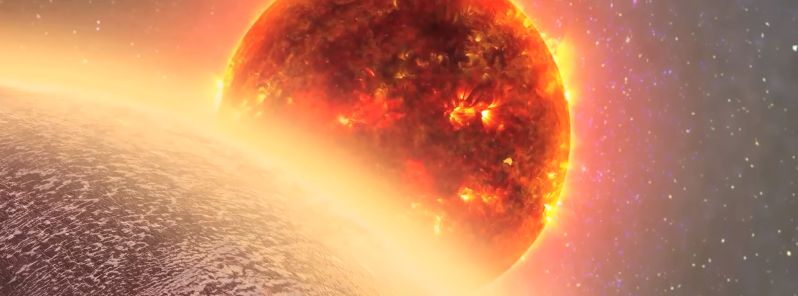New Earth-like exoplanet discovered, only 39 light years away

Scientists have discovered a new exoplanet in our stellar neighborhood, only 39 light years from Earth, Massachusetts Institute of Technology announced on November 11, 2015. The planet shows no signs of being capable of hosting any life, however it is the closest Earth-sized exoplanet discovered so far.
The newly discovered exoplanet has been discovered using the MEarth-South Observatory, an array of eight 40 cm (1.3 feet) wide robotic telescopes located in the mountains of Chile and led by the Harvard University. This telescope array is used to monitor small, nearby class of M dwarfs stars, frequently orbited by planets.
The planet has been named GJ 1132b and its size has been estimated comparable to Earth's. It is of rocky composition and its surface temperatures have been estimated to reach about 260 °C (500 °F). GJ 1132b is believed to be tidally locked, holding a permanent day and night side, similar to our Moon.
The planet probably holds no liquid water due to its high surface temperatures, which means it's most likely uninhabitable. However, experts think its environment is cool enough to hold abundant atmosphere gases.

Video credit: Melanie Gonick/MIT (additional imagery and animations courtesy of the researchers and NASA)
"If we find this pretty hot planet has managed to hang onto its atmosphere over the billions of years it’s been around, that bodes well for the long-term goal of studying cooler planets that could have life. We finally have a target to point our telescopes at, and [can] dig much deeper into the workings of a rocky exoplanet, and what makes it tick," said Zachory Berta-Thompson, a postdoc in MIT’s Kavli Institute for Astrophysics and Space Research.
The discovery was made on May 10, as one of the telescopes detected a faint dip from a GJ 1132 star, located 39 light years away from our planet.
"Our galaxy spans about 100 000 light years. So this is definitely a very nearby solar neighborhood star," Berta-Thompson explained.
Scientist calculated the planet is about 1.2 times the size of Earth, according to the amount of starlight it blocks, and by measuring the wobble of its host star, they have come to a conclusion its mass is about 1.6 times Earth's. Taking into the account this information, the scientists have been able to deduce the planet has a rocky composition, like our planet. However, its temperature is where every similarity to Earth vanishes.
"The temperature of the planet is about as hot as your oven will go, so it’s like burnt-cookie hot. It’s too hot to be habitable – there’s no way there’s liquid water on the surface. But it is a lot cooler than the other rocky planets that we know of."
This discovery is interesting because most of the rocky planets that have been discovered so far are too hot to keep an atmosphere, but GJ 1132b is cool enough to be capable of retaining atmosphere, according to the scientists.
Berta Thompson hopes the astronomers will get to use the James Webb Space Telescope (JWST) which is planned to get launched in 2018 to study the color, chemical composition and winds of the planet's atmosphere.
"We think it’s the first opportunity we have to point our telescopes at a rocky exoplanet and get that kind of detail, to be able to measure the color of its sunset, or the speed of its winds, and really learn how rocky planets work out there in the universe. Those will be exciting observations to make," Berta-Thompson said.
The MIT-led NASA Transiting Exoplanet Survey Satellite (TESS) will search the entire sky for nearby planets, and may find many more that would serve as good targets for JWST.
"Of the billions of star systems in the Milky Way galaxy, about 500 are closer than GJ 1132. TESS will find planets around some of these stars, and those planets will be valuable comparisons for understanding GJ 1132b and rocky planets in general."
Jonathan Fortney, a professor of astronomy and physics at the University of California at Santa Cruz although not involved in the research, thinks GJ 1123b is much cooler then other nearby rocky planets discovered so far, also indicating that it holds a substantial atmosphere.
"What is tremendously exciting to me is that this planet could be a real ‘cousin’ of Venus and Earth. I think that this planet’s atmosphere, when we are able to try to determine what it is made of, will be an interesting data point in understanding the diversity in atmospheric composition for Earth-sized planets. In our solar system, we only have two data points: Earth and Venus. Before we can understand habitability, I think we need to understand the range of atmospheres that nature makes, and why," said Fortney.
Reference:
- "A rocky planet transiting a nearby low-mass star" Zachory K. Berta-Thompson et al – Nature (2015) – doi:10.1038/nature15762
Featured image: New exoplanet, Artist's impression. Image credit: Dana Berry/MIT

Commenting rules and guidelines
We value the thoughts and opinions of our readers and welcome healthy discussions on our website. In order to maintain a respectful and positive community, we ask that all commenters follow these rules.